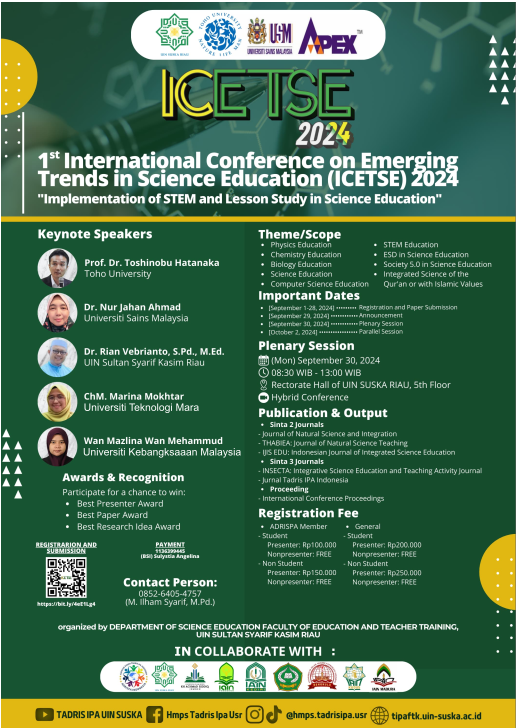Development of Wordwall Web-Based Interactive Learning Media on Living Things Classification Materials to Increase Student's Interest in Learning
Main Article Content
Abstract
Learning media is a very important means in the process of student learning activities. The boring learning process makes students' interest in learning decrease, this is because teachers still use the lecture method as the learning method used. This study uses the research and development/RnD method with the ADDIE model consisting of Analysis, Design, Development, Implementation, and Evaluation. The data analysis technique used in measuring the level of validity is using a Likert scale and to measure the effectiveness of a medium, a Paired Sample T-Test hypothesis test is carried out. The average percentage results obtained from the validity test of media experts were 95% with a very valid category, from material experts it was 90% with a very valid category, and from user assessments it was 93.75% with a very valid category. The results obtained from the normality test show that the pre-interest value data has a Sig. (2-tailed) value of 0.200, while the post-interest value also has a value. Sig. (2- tailed) of 0.200. A significance value greater than 0.05 indicates that the pre-interest and post-interest data are normally distributed. Meanwhile, the Paired Sample T-Test hypothesis test in the student learning interest questionnaire received a score of sig. (2-tailed) by 0.00, so sig. (2-tailed) < 0.05. Then H0 is rejected and H1 is accepted. Based on these data, it can be concluded that web-based interactive learning media word wall has a significant influence in increasing learning interest in classification materials.
Article Details
References
Branch, Robert Maribe. (2009). Instructional Design: The ADDIE Approach. New York: Springer.
Daryanto. (2013). Menyusun Modul Bahan Ajar Untuk Persiapan Guru Dalam Mengajar. Yogyakarta: Gava Media.
Haris, Abdul, and Nurhayati. (2014). Psikologi Dalam Pendidikan. Bandung: Alfabeta.
Jalinus, Nizwardi. (2016). Media Dan Sumber Pembelajaran. Jakarta: Kencana Press.
Lestari, Novia, and Rini Wirasty. (2019). Pemanfaatan Multimedia Dalam Media Pembelajaran Interaktif Untuk Meningkatkan Minat Belajar Siswa. Amaliah: Jurnal Pengabdian Kepada Masyarakat, 3(2), 349–353, https://doi.org/10.32696/ajpkm.v3i2.289
Safitri, Ida, and Nurul Fadillah. (2021). Pengembangan Bahan Ajar Tematik Berbasis Sains Teknologi Masyarakat (STM) Untuk Meningkatkan Kompetensi Siswa Di SDN 1 Alue Dua. Jurnal Tunas Bangsa, 8(1), 55.
Slameto. (2010). Belajar Dan Faktor-Faktor Yang Mempengaruhi. Jakarta: Rienka Cipta.
Situmorang, Masni V., & Winda Purba. (2020). Pengaruh Media Pembelajaran Interaktif Biologi Terhadap Hasil Belajar. JUBIOKU Jurnal Biologiku, 3(1), 14–26.
Sudaryono. (2016). Metode Penelitian Pendidikan. Jakarta: Kencana.
Sugiyono. (2016). Metode Penelitian Kuantitatif, Kualitatif dan R&D. Bandung: Alfabeta.
Suja’i, Cecep Abdul Muhlis. (2023). Implementasi Kurikulum Merdeka Dalam Membangun Karakter Siswa Pada Mata Pelajaran Pendidikan Agama Islam Di SMP Nurul Qomar. HASBUNA: Jurnal Pendidikan Islam, 2(1), 147–70
Suparlan. (2019). Teori Konstruktivisme Dalam Pembelajaran. Islamika, 1(2), 79–88. https://doi.org/doi.org/10.36088/islamika.v1i2.208
Pradani, Tatsa Galuh. (2022). Penggunaan Media Pembelajaran Wordwall Untuk Meningkatkan Minat Dan Motivasi Belajar Siswa Pada Pembelajaran IPA Di Sekolah Dasar. Educenter: Jurnal Ilmiah Pendidikan, 1(11), 806–11.
Utami, I. GA Lokita Purnamika. (2016). Teori Konstruktivisme Dan Teori Sosiokultural: Aplikasi Dalam Pengajaran Bahasa Inggris. Prasi: Jurnal Bahasa, Seni, Dan Pengajarannya, 11(1).
Zulfah, Nadhirotuz. (2023). Pemanfaatan Media Game Edukasi Wordwall Untuk Meningkatkan Minat Belajar Siswa. Pubmedia Jurnal Penelitian Tindakan Kelas Indonesia, 1(1), 11–11.
